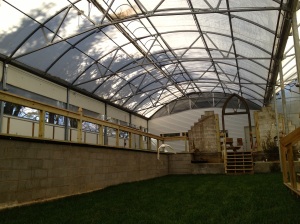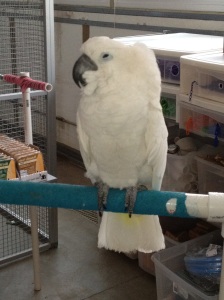
I’m sure many people are ready for this winter to be over. I’m a big lover of the snow and cold but this winter has been long enough and I’m ready for some warmer temperatures. The birds are also. I love the summer for them because they get the fresh air, the sun, and all of the benefits of their aviary. I’m a big advocate of aviaries for our birds because of all of the health benefits, mental stimulation, and physical stimulation it offers them. I like helping people visualize how they can incorporate aviaries for their birds whether they live on 20 acres, in a condominium, an apartment, or in a town house. Where there is an idea, there is an aviary!
Anyway, back to winter and being cooped up because of the temperatures. Each day I try to get each bird out for interaction with me, interaction with other things in their environment and just for a change in scenery.The other day I was working at my desk that overlooks the aviary and Rico was perched on his favorite perch, which happens to be my head. Whatever it was that I was working on, I noticed Rico began to bob up and down on my head. I opened my phone and flipped the view backwards so I could see where Rico was looking. He was bobbing up and down, holding his wings out, and looking out the window at the aviary. So much body language here and these signs all together gave me a hint that he may want to go out into the aviary. I put down what I was doing and out into the aviary we walked.
I sat Rico down on the banister in the aviary and ran to the other side. I called him to my hand and after a few struts on

the banister he was off in flight. Right to my hand he flew. All of that fresh air going into his air sacs, being distributed to his bones and organs. How healthy this is for him, how fun it is for him and for me to be a part of it.
Not all of my birds fly. One hasn’t flown in his life, which is my greenwing macaw, Murray who is about to turn 9 years old. Then I have one that is a beautiful flyer but doesn’t know how to land. This would be Rocky, my moluccan cockatoo who is a little over 13 years old. Let me correct myself…Rocky is still working on perfecting his landing. Myself and the volunteers here at the center are helping him work on his landings. When Rocky flies, he doesn’t know how to land and when he lands he has to crash into something to stop. I no longer encourage him to fly until we have his landing gear perfected. We have not clipped his wings, we just don’t encourage him to fly yet. He loves to run so we are encouraging him to run while we work on training him to land and use his wings, tail feathers and feet to stop. He’s getting pretty good at this. We hope to be posting photos and videos soon of Rocky’s flights through the aviary this summer.
So Rocky runs and in the meantime we are focusing on hanging vines in the aviary to give Murray more means of locomotion and choices in transportation through the aviary. When birds have more control in their environment, how to navigate it and choices in navigation, I see it having a huge impact on decreasing behavior issues such as screaming, feather destructive behaviors, and issues related to stress, aggression and anxiety.
Before I took Rico out of his cage and before he was on my head, I could tell he was up for a change in his environment, which was his cage. Keeping animals in the same space without changing that space or having different areas to move to, creates a stagnant environment. Objects and interactions in that environment become predictable and studies show that with predictability comes boredom. I could see Rico was getting bored and was in need for a change. If I didn’t provide change I could tell undesirable behaviors were about to happen such as screaming, hunkering down and flapping wings in anticipation which brings along signs of anxiety, and probably grabbing a toy and banging it on the side of the cage. I don’t like seeing any of these signs in my birds because of the stress I see that it brings out in them.

After one flight across the aviary I could tell Rico was still interested in flying. Down into the pit I went and I called him to my hand from there. Rico has been showing signs of not understanding how to fly to my hand when I am down in the pit. I’m not sure what it is but he’s not used to flying to me when I call him from different elevations. We’ve slowly been working on this at his comfort level while slowly increasing the complexity in elevation when calling him. Sometimes I’ll go one or two steps down into the pit and call him. The pit is about 4 1/2′ below regular ground level. Then I bring out the ladder, walk up a few rungs and call him up to my hand. Each time I step down a step or up a rung allowing him the slow change and adaptability in depth or elevation. This is a process called shaping; reinforcing small approximations toward the target behavior, and in this instance the target behavior was him still flying to my hand and gradual changes in elevation. In working on this several times in the past, this time I ran into the pit and called him to my hand. He flew over the banister and down into the pit and on my hand like he’s done it a million times before. He yelled “Yahoo!” as soon as he landed on my hand and you bet I yelled it back to him. I love having this interaction with birds and especially with the ones under my care. His learning something new (depth perception) in his new flying environment is not only physically stimulating for him, it is also mentally stimulating. He is learning from changes in his environment. When I slowly integrate change at their pace, I see the birds in my care dealing with unforeseen changes very readily. I want this for them, for their health, and for their future.
Not everyone has room like this to fly their birds. I understand that. A few months ago I didn’t either. I lived in a small house with five parrots and a crow with a Barred Owl in a mew in my backyard. I know what small living quarters are like with birds. This didn’t stop me from getting birds out and flying them all over the house, increasing complexity by having learn to fly through doorways and up the stairs. Rocky played fetch by running all over the first floor. Murray would swing from a vine in the aviary. Molly would soak up the sun for hours in the aviary, obviously with the option to move into the shade. I noticed that if I were to get them out of their cages and get them running, flying, and/or flapping their wings, energy was being burnt off, behavior issues would decrease, and the more they seemed content with perching, sleeping, preening, and foraging for the next several hours.
My point in this post is to share how a few minutes of burning off energy in large amounts can greatly impact behavior

or the potential for undesired behavior issues not to happen. Less than five minutes of flying in the aviary for Rico in the photos above, and we went back into the Birdroom and Rico flew straight for one of the perches and rest and relaxation were in his near future and mine. Parrots are intelligent creatures that have a lot of energy to burn and they want to put that mind and body to use. This is why I train them. I like putting their minds to use. I like providing environments where they can continue to learn and manipulate that environment. When I provide environments like this and interactions like this, I see our relationships skyrocketing.
For more information or ideas on how to build aviaries or extended exercise areas in your house for your birds, take a look at the Enrichment and Aviary section on my website at LaraJoseph.com. I will be building more aviaries this summer and plan on sharing my plans on my website. For everyday quick tips and ideas on behavior change, training tips, and enrichment ideas, sign up to my Behavior, Training, & Enrichment page on Facebook. I hope to see you there. I’d love to see photos and videos of your enclosures and how you exercise your birds.
Leave a Reply